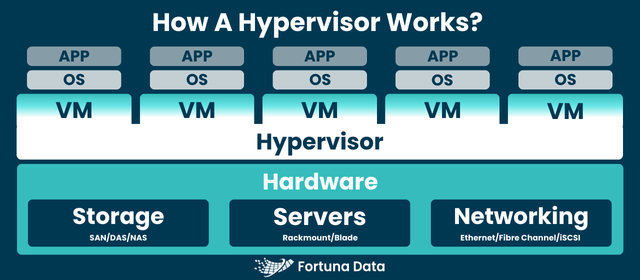The two types of hypervisors are Type 1 and Type 2.
Operates on Physical Components and Operating System of Host Device.
The level of performance ranges from high to moderate.
The use case involves various platforms such as enterprise, cloud, server, and desktop, catering to tasks such as testing and development.
"Ensuring security through both strong hardware and operating system-level isolation measures."
Some popular virtualisation software includes ESXi, Hyper-V, and Xen for server use and Workstation and VirtualBox for personal use.
Additional options for Hypervisor models.
- Containerised virtual environments, such as Docker, utilise different principles than traditional VMs. However, the underlying features of the operating system can mirror certain elements of a hypervisor's ability to allocate resources and provide isolation.
- Modern hybrid architectures combine bare-metal and hosted capabilities to cater to specific use cases.
Why Are Hypervisors Important?
The significance of hypervisors lies in their ability to efficiently manage and partition the physical resources of a computer system. They enable multiple operating systems to run simultaneously, maximising the utilisation of hardware and enhancing flexibility in resource allocation. This critical technology plays a crucial role in modern computing environments.
Hypervisors offer significant benefits to both IT infrastructure and management, driving powerful improvements.
Some advantages of this product include its versatility, convenience, and efficiency.
- Hypervisors are crucial for optimising resources as they prevent hardware from being underutilised by allowing multiple workloads to be hosted on a single server.
- Cutting Costs: By consolidating physical servers, organisations can save significantly on hardware, energy, and maintenance expenses.
- Flexibility in cloud platforms allows for rapid deployment, cloning, and migration of VMs, which greatly enhances development, testing, and scalability.
- Hypervisors serve to provide both security and isolation for VMs, preventing the potential spread of faults or compromises from one VM to others.
- Virtualisation streamlines backup, disaster recovery, and failover scenarios for improved operational resilience in businesses.
- Virtualisation streamlines backup, disaster recovery, and failover scenarios for improved operational resilience in businesses.
- Legacy Support allows for the simultaneous operation of multiple OS versions and legacy applications on up-to-date hardware, effectively prolonging their lifespan.
The various scenarios in which something can be utilised and the functions that it entails
- Cloud computing relies on hypervisors to offer scalable multi-tenant environments across all public cloud platforms.
- Server consolidation helps to decrease physical server clutter, minimise power usage, and reduce cooling demands in present-day data centres.
- Experiment safely with new OS versions, configurations, and software environments through our Test and Development feature.
- Virtual desktops, securely delivered to users and centrally managed, are ideal for both remote work and BYOD.
- In terms of disaster recovery, VMs can be transferred, backed up, or duplicated with limited interruption
The security concerns associated with hypervisors.
- Hypervisors provide both increased isolation and security for virtual machines, but they also serve as vital infrastructure that can be targeted by attackers. Important security elements include:
- The isolation between environments is an important aspect to consider. Virtual machines, or VMs, are designed to be sandboxed, which means any vulnerabilities within one VM typically cannot impact others.
- Management consoles enforce user authentication and ensure privilege checks are carried out for access control.
- Easily bring back VMs to a secure state in the event of an infection or malfunction through snapshotting and rollback.
Possible hazards:
- Hypervisor escape refers to flaws that enable harmful code to escape a virtual machine and impact either the host or other virtual machines.
- Management vulnerability can be mitigated by implementing strict control and regular audits of hypervisor admin interfaces.
- Exploring the Technical Mechanics of a Hypervisor
- The hypervisor functions through the abstraction of physical resources, controlling VM execution, and ensuring strict segregation.
- During the boot sequence, the hypervisor is loaded first, preceding any guest operating system, to initialise hardware access.
- Resource allocation involves dividing up available CPU, memory, storage, and networking resources among virtual machines. These shares are constantly adjusted based on demand
- The hypervisor employs advanced algorithms to schedule VM tasks on physical processors, ensuring a balance between performance and responsiveness
- Device management involves virtualising various input/output devices, such as disk drives, network adapters, and graphics cards. This allows virtual machines to operate under the assumption that they have exclusive access to hardware resources.
- Administrators can easily keep track of performance, health, and compliance through monitoring and control. This allows them to conveniently snapshot, migrate, suspend, or clone VMs as needed.
The implementation details may differ, depending on the architecture being used (Type 1 or Type 2).
- Type 1 is responsible for both hardware management and functioning as the control plane.
- Type 2 communicates with the host operating system, which carries out hardware operations on its behalf.
When choosing the appropriate hypervisor, there are certain factors that must be considered in order to make the best decision.
When selecting a hypervisor, it is important for organisations to consider:
- When it comes to performance, is low latency or high throughput more important?
- Scalability: Is there potential for rapid growth in the environment
- Is the hypervisor compatible with required OS types and hardware?
- Are advanced monitoring and automation capabilities necessary for management tools?
- What level of isolation and control is required for the security measures?
- When comparing cost structures, it is important to consider the differences between open-source and commercial licensing models.
Type 2 hypervisors may be suitable for small businesses and developers, while Type 1 hypervisors are typically the preferred choice for large enterprises, data centres, and cloud infrastructure due to their strong reliability and high performance.
The outlook for hypervisors is promising, as they continue to play a pivotal role in virtualisation technology.
As IT trends progress, so do hypervisors. Some of the latest developments in this technology include:
- The incorporation of containers into platforms has resulted in a combination of hypervisor-based and container-based virtualisation. This integration allows for improved efficiency, portability, and security.
- Hypervisors are implemented on edge devices and micro data centres for the purpose of enabling distributed computing in closer proximity to users and IoT devices.
- Continual research continues to bolster the hypervisor's resilience against emerging threat vectors, further reinforcing security measures
Leading technology companies remain committed to enhancing hypervisor performance, intelligence, and user-friendliness, as they prioritise the inclusion of hybrid cloud and multi-cloud orchestration capabilities
In conclusion, it is evident that the results clearly support our initial hypothesis.
Hypervisors are a foundational technology that drives virtualisation, empowering businesses to optimise resource usage, decrease expenses, increase adaptability, and provide dependable and scalable IT solutions. Whether overseeing dynamic desktop setups or robust cloud-based data centres, hypervisors remain integral for advanced computing needs.
Gaining insight into the differences between Type 1 and Type 2 hypervisors, as well as their unique designs and advantages, enables IT experts to make educated choices regarding virtualisation plans. This lays the groundwork for advancements in both corporate and personal computing.
This all-inclusive piece delves into hypervisors, spanning their core function and structure to real-world implications, categories, implementation choices, security factors, and upcoming developments. As a central component of contemporary virtualised and cloud-based IT environments, the hypervisor often operates unnoticed.

